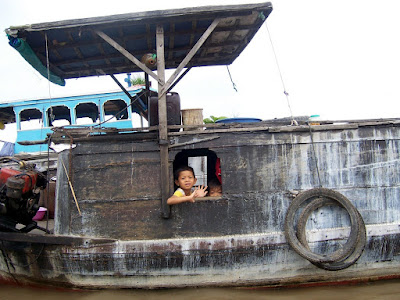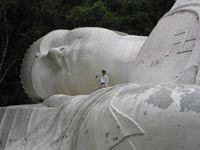Wednesday, August 22, 2007
Luang Prabang, Laos
Cambodia
The Happy Ranch in Siem Reap, Cambodia offers 3 hour horseback riding trips through the countryside. There was a small temple out there as well. It was absoultely beautiful!
Tuesday, August 14, 2007
HAPPY BIRTHDAY!
Also, shoutout to my Theta girlies who have been following my trip! I think I am going to be as big as Perez Hilton pretty soon. Thank you for you interest in my travels. I love you all!
Siem Reap, Cambodia
Wednesday, August 8, 2007
The Zoo
The Floating Market











me and my AK-47
Here is what Wikipedia has to say about the Cu Chi tunnels, because I don't feel like thinking right now:
The tunnels of Củ Chi are an immense network of connecting underground tunnels located in the Cu Chi district of Vietnam, and are part of a much larger network of tunnels that underlie much of the country. The Củ Chi tunnels were the location of several military campaigns during the Vietnam War, and were the National Front for the Liberation of South Vietnam's base of operations for the Tet Offensive in 1968.
The tunnels were used by NLF guerrillas as hiding spots during combat, as well as serving as communication and supply routes, hospitals, food and weapon caches and living quarters for numerous guerrilla fighters. The role of the tunnel systems should not be underestimated in its importance to the NLF in resisting American operations and protracting the war, eventually persuading the weary Americans into withdrawal.
American soldiers used the term "Black Echo" to describe the conditions within the tunnels. For the NLF, life in the tunnels was difficult. Air, food and water were scarce and the tunnels were infested with ants, poisonous centipedes, spiders and mosquitoes. Most of the time, guerrillas would spend the day in the tunnels working or resting and come out only at night to scavenge supplies, tend their crops or engage the enemy in battle. Sometimes, during periods of heavy bombing or American troop movement, they would be forced to remain underground for many days at a time. Sickness was rampant among the people living in the tunnels; especially malaria, which accounted for the second largest cause of death next to battle wounds. A captured NLF report suggests that at any given time half of a PLAF unit had malaria and that “one-hundred percent had intestinal parasites of significance.” In spite of these hardships, the NLF managed to wage successful campaigns against a conscripted army that was technologically far superior.
YAY! Thanks Wikipedia! We recently visited the tunnels with Hailey's mom and brother--it was fascinating. Just outside of the touring area, there is a field set up for tourists to shoot guns... Here are some pics:








 Below: a bedroom in the tunnels. That wood plank is a bed. I climbed up into this room through the hole on the left side of the floor.
Below: a bedroom in the tunnels. That wood plank is a bed. I climbed up into this room through the hole on the left side of the floor.


 A camouflaged trap. It lies flat, and when stepped on, the intruder falls into a lovely bed of sharp bamboo spears. Excess shrapnel from the American weapons were also used in traps.
A camouflaged trap. It lies flat, and when stepped on, the intruder falls into a lovely bed of sharp bamboo spears. Excess shrapnel from the American weapons were also used in traps. Below: The 'menu' at the shooting range. I opted for the AK 47, the M 16 and the Machine Gun. A little more than an dollar per bullet.
Below: The 'menu' at the shooting range. I opted for the AK 47, the M 16 and the Machine Gun. A little more than an dollar per bullet.



Monday, July 30, 2007
Black Cat


The Beach


 Above: A picture of a kite surfer (the guy on the top--his parachute is out of the frame) and a wind surfer. The kite surfers would get so much air!!
Above: A picture of a kite surfer (the guy on the top--his parachute is out of the frame) and a wind surfer. The kite surfers would get so much air!! Below: Our resort, The Sailing Club. We stayed in thatched roofed bungalow's and our bathroom was outside, so we got to shower under the palm trees. Absolutely beautiful.
Below: Our resort, The Sailing Club. We stayed in thatched roofed bungalow's and our bathroom was outside, so we got to shower under the palm trees. Absolutely beautiful.



We took a tour through a beautiful tropical rain forest an hour out of Mui Ne and rode a gondola to the top of Takou Mountain. In 1879, a pagoda was built at the top of the mountain. A statue of a reclining Buddha lies at the highest position on Takou Mountain. The statue is about 160 feet long, and is the largest reclining buddha in Vietnam. Although tourists are no longer able to climb in the statue (access was through the Buddha's ear), we were able to climb on top. Unfortunately, my camera ran out of batteries once we reached the pagoda at the top, so the three pictures of the Buddha shown are taken from the internet to give you an idea of its massive size.
 Above: the gondolas we rode to the top
Above: the gondolas we rode to the top
 Above: Hiking up to the reclining Buddha
Above: Hiking up to the reclining Buddha
















